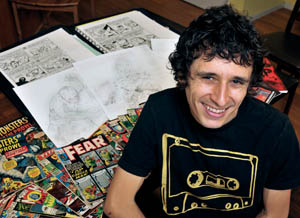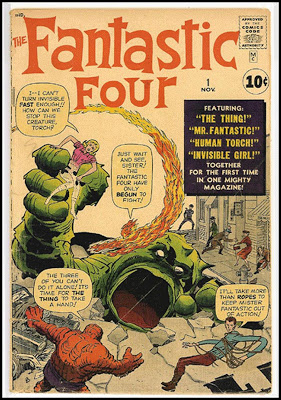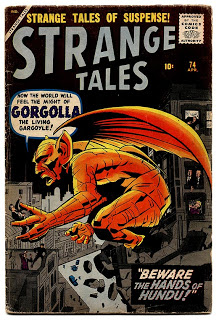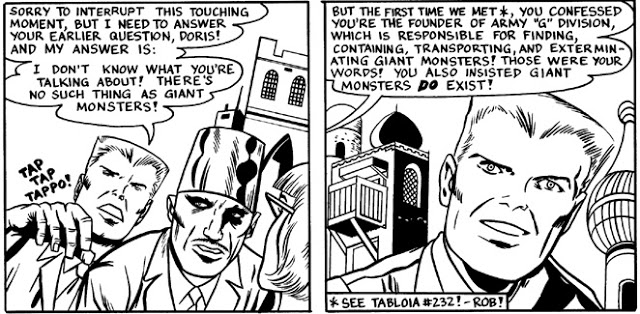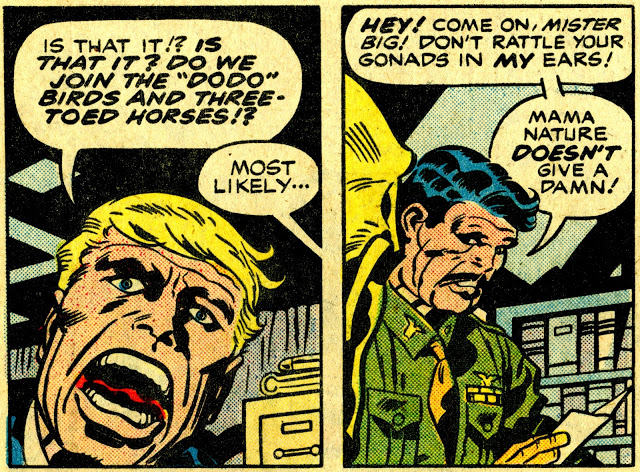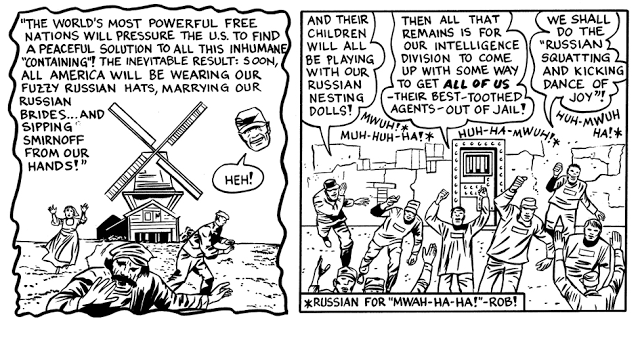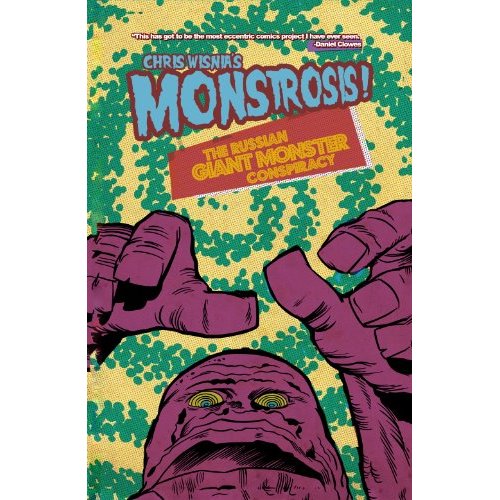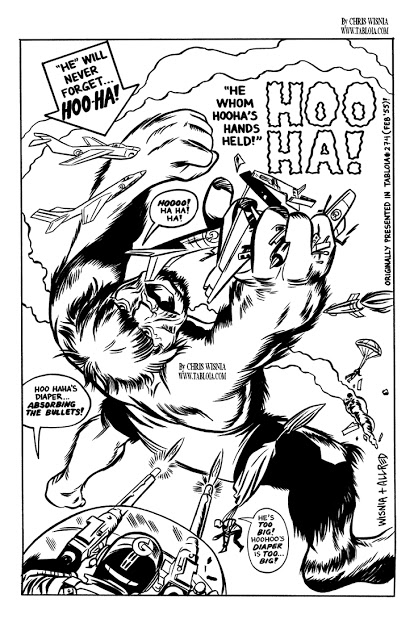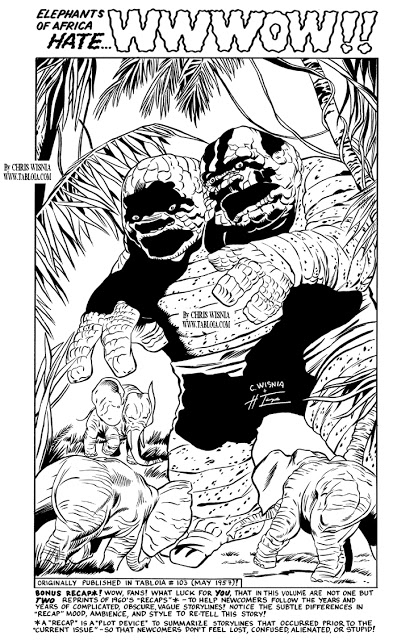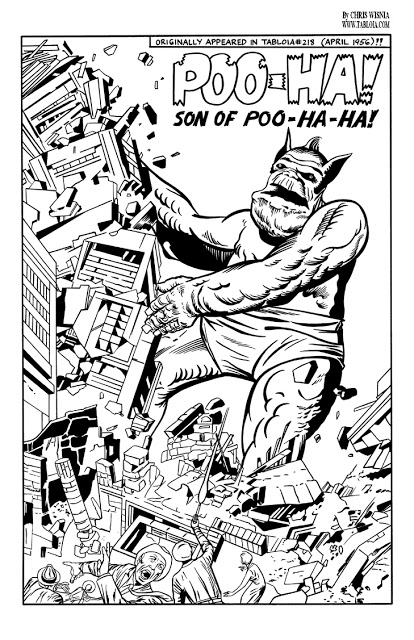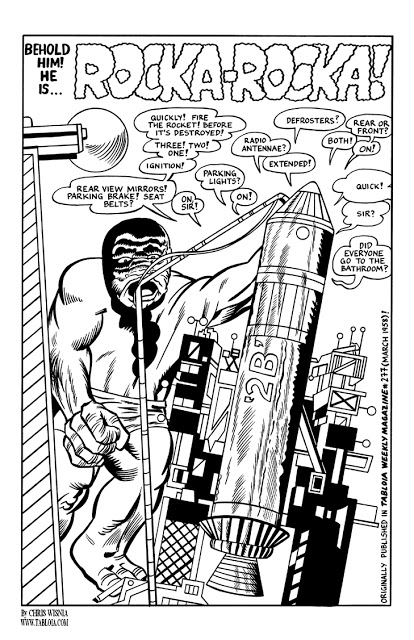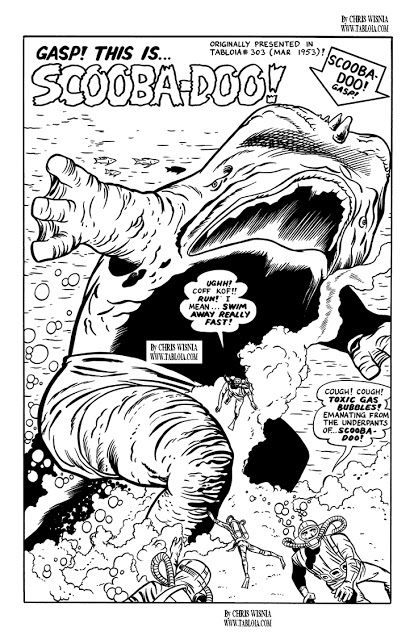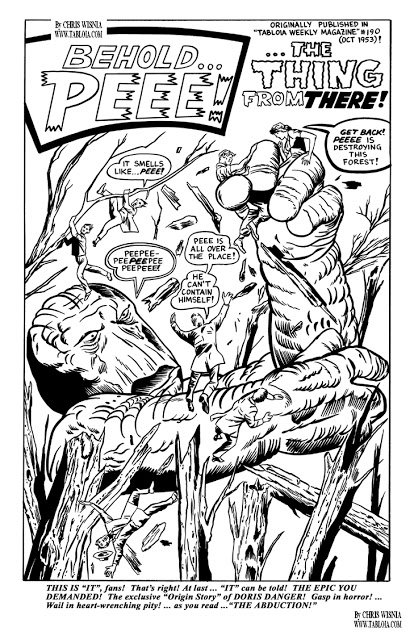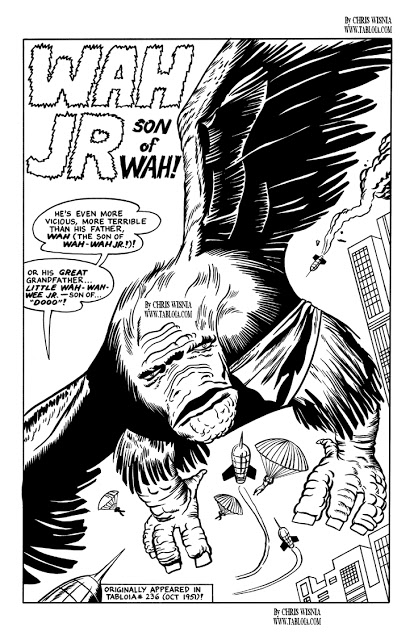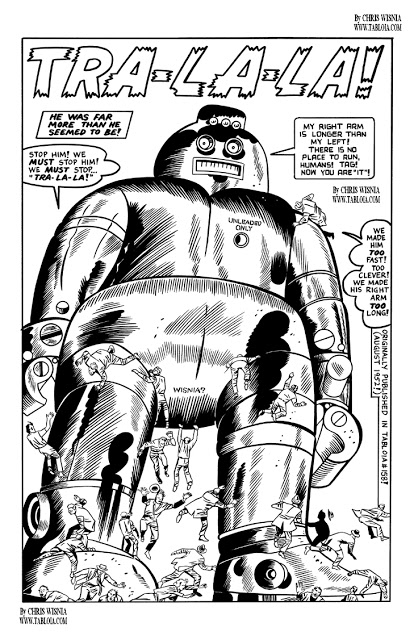Giant Monsters and Comics go together like chocolate and peanut butter.
Unfortunately, this delicious mash-up has been forgotten by most, especially the modern comic book industry.
Thankfully, cartoonist Chris Wisnia knows this and continues to make the kinds of comics that true comic geeks salivate over.
For several years, Wisnia’s Doris Danger Adventures have appeared in both print and online.
Tomorrow, at San Francisco’s Alternate Press Expo (APE), he’ll debut his latest collection, Monstrosis: The Giant Russian Monster Conspiracy, which will be distributed exclusively through Amazon, at the Slave Labor Graphics Booth (117, 118, 119)
We chatted a bit about the strip, his influences and more.
What was the genesis of Doris Danger?
Okay, here’s the long historical perspective. Jack Kirby and Stan Lee created most of the Marvel Universe together – the Fantastic Four, the Hulk, X-Men, The Avengers, Thor – But right before that, back in the late 1950’s-early 1960’s, they were putting out any genre of comics they thought would sell – war, western, romance, horror. And then they started doing this crazy horror sub-genre: giant monsters. Tales to Astonish, Strange Tales, Amazing Fantasy. (They were reprinted in the 1970’s under the titles, Creatures on the Loose, Where Monsters Dwell).
Those are the comics that transitioned into Marvel’s super hero line, as you can see with a giant monster on the cover of Fantastic Four #1.
Dick Ayers inked most of those monster stories, and I met him at San Diego Comic-Con back in 2002. He was one of the few artists who was nurturing and supportive of my work.
He gave me his contact info, and on my way home, I had this sudden wild vision to make a Jack Kirby style giant monster story, and ask if he would ink it. And he did!
So that was the primary impetus for the artistic style and writing tone. As far as the actual story, I was thinking about comics as a serialized medium with no beginning or end.
When I first began reading comics, I picked up issue #207 of something, and it began with the character getting out of a cliffhanger, and I didn’t know who anyone was or what was going on and then it ended in a different cliffhanger, but I enjoyed it enough that next time I was at a supermarket (a few months later) I picked up issue #210 – so it was a completely different cliffhanger again and I didn’t know how the character got out of the previous cliff-hanger, and I recognized some characters but now there were other ones I hadn’t seen before, and I still didn’t know what was going on.
Then a friend loaned me issue #178, so I began to see more story/character threads, and now I understood why this happened in issue #207 but he’s got a different girlfriend, and that guy was a bad guy but now he’s a good guy and not a super hero yet, and I’m starting to piece some things together. In this fashion, comics are organic, non-linear, and like getting a giant puzzle, and slowly realizing a couple pieces fit together.
I thought this was a great exercise, to try telling a story as if it’s been running for a decades, and referring to events that the reader wouldn’t necessarily have access to. “See issue #207, fans!”
So the Doris Danger Giant Monster stories are about cherishing and loving that aspect of reading comics, of not owning the complete hardcover collection or the full season dvd set, and not knowing the whole story but hopefully not really needing to and just enjoying the ride. The thrill of trying to figure it all out and piece it together and get hold of all the little tidbits to make sense of it all somehow.
When starting a story, what comes first the monster or the plot?
I consider the monsters in the story kind of peripheral or incidental, which is ironic, because every story – which is only five or so pages – I have these huge giant monster splash pages, and at least one more half page of a giant monster.
Because of the way the stories are structured, I write them in random bursts. I’ll be thinking of a character, or a situation, and come up with a gag, and I’ll jot that down on a scrap of paper. I’ve got hundreds of scraps of paper that I throw into a file. When I have time, I go through all the paper scraps and organize them into a word document by subject, so it’s just a laundry list of gags or scenes. Having been developing the stories for ten years now, I’ve literally got hundreds of pages of notes filling in all the plot lines that I have yet to publish.
When I’m ready to sit down and make the stories, I think about what subjects I want to cover, I go through my notes and construct the pages by saying, “Okay, I’m going to include this and this and this,” and then there’s the story. As I lay out the pages and begin drawing, I continue brainstorming the dialogue, so that it isn’t really finalized until it goes to the printer. I usually have to remember to fit a monster into it somewhere, because I’m so busy going in other directions.
Obviously Jack Kirby monster comics are a big influence. Do you remember the first time you came across them and are there any particular stories or monsters that are a favorite?
When I was a kid, I couldn’t stand Kirby’s work. I used to think, “That guy can’t draw. He’s got no understanding of anatomy. His women are hideous. Their finger tips look like they were sharpened in a pencil sharpener. All the guys look like their bodies are made of barrels. He draws the most amateurish looking hands I’ve ever seen. Why are all the people’s bodies shiny? Why is everyone’s mouth an upside down triangle?” I would literally get furious if I brought a comic home and opened it up and realized Kirby had drawn it.
So I didn’t give him any thought until after I graduated from college. I studied studio art at UC Davis, and after I got out, I worked next door to a comic shop and started getting into comics and talking about comics again. And I started thinking about Kirby and my utter distaste for his work, and wondering why it evoked such strong emotions in me. And I started thinking about how, in art, I don’t have a problem if Van Gogh or Picasso or Matisse or Rousseau don’t draw people that look like real people. Being an artist has nothing to do with your ability to photo-realistically capture your subject. So I re-examined Kirby’s work with a fresh perspective, and realized how much he does capture. So much raw power, the energy BURSTS from his pages, like a punch in your guts.
The other thing is, I feel “low art” and pop culture often reveal a lot more than we give them credit for. Soap operas, professional wrestling, bad pop music. It can be absolutely, painfully awful from a “photo-realistic” standpoint, if you know what I mean.
But there can be something naked and disturbing and engaging and visceral in it too, it can really capture other things in ways that surprise you.
I love anything Kirby I can get my hands on now. I would say my favorite monster stories are Colossus and the Colossus sequel, because there are so many fantastic splash images in those stories.
Also “X The Thing That Lives,” “The Brute That Walks,” Vandoom, Gorgilla, who was in a couple stories… It would be hard to narrow down which are my very favorite two hundred stories.
Most of your stories are several pages and very dense, which is a throwback to older comics. Do you stick to this economy of pages as homage to the original stories or is it just a matter of preference?
The stories are an homage to those older comics, so that’s very much done to give a sense of that era. The original monster stories were all five to ten pages, tops. Where I broke the style is that all those old stories were singular, one-shot, self-contained stories, whereas I chose to make mine serialized. So that is more a reference to tv shows like Lost or the X-Files.
I like to think, in the case of these comics, the stylistic look and writing style add to the humor as well, although I appreciate that people may see the work and think, “My God, half of that panel is text. I’m not interested in taking that much time to read a comic.”
I make other comics in other styles, and they look nothing like this, artistically, in layout, or in text. I try to make the look and feel fit the story I’m trying to tell.
What’s next for Doris Danger and do you have any other projects in the works?
I don’t know what is next for Doris Danger. Because it’s a weird comic, parodying an obscure, specific genre, my concern is that sales may not justify a third volume, which would be too bad, because I still have a lot of stories that I think would be fun to tell. I feel like I’m really finally hitting my stride with the quality of art and story, and with my delivery and timing for the joke-telling. So we’ll see what happens on that end. I have two very specific “next chapters” plotted out for additional volumes.
I’ve been working with someone to try and develop a web comic of the series, which would be interactive. As I mentioned, right now the comics are purposely disjointed and non-linear, jumping from chapter to chapter in a difficult-to-comprehend “randomness,” as if you found a stack of comics in a chest in the attic, and issues were out of order and not a complete run. My dream with a web comic is for the reader to be able to click on a character or setting or subject (“robots,” “giant monsters,” “Fez-wearing cult,” “hillbillies”) and link to its first/previous/next appearance, or when the editor notes, “See issue #188,” you could click it and actually see that issue – so that the experiencing of the story-telling becomes almost like a Choose Your Own Adventure. You want to learn more about FBI Agent Felk? You can’t remember what Army Commander Luke Luggash is referencing about race car stickers? Just click on them. For the style of humor I’m using to pay off, you kind of have to pay close attention, and having options like this I think would satisfy a lot of concerns or criticisms people have made of the comic itself.
I think I can comfortably say there isn’t really any other comic structured in such a way to pull something like this off. I think it could be really exciting.
Besides Kirby who or what are the biggest influences on your work?
In comics, I love Mike Mignola’s compositions and use of black, Alan Moore’s brilliant story-telling, Mike Allred’s line work and zaniness and sheer fun. I love Steve Ditko, Wally Wood, Bruno Premiani. There are so many greats… Who are my favorite two hundred? That said, I would say I’m influenced as much by film and literature as by comics. Film noir, Alfred Hitchcock, old 1940’s horror films, Twilight Zone.
What are you currently geeking out over?
I’ve been so busy lately, I haven’t had time to geek out on anything. I have two kids, a day job, and comics take SO MUCH TIME to produce one page. The only reading I get done is on the toilet. I’ve been reading a Doc Savage paperback.
After the jump, check out some giant monsters from the imagination of Mr. Wisnia.




































































































